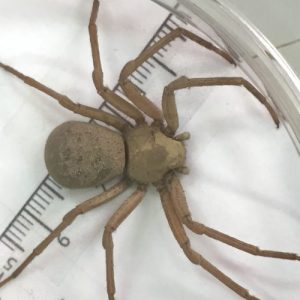At the University of Antofagasta, important research has been carried out on the corner spider bite.
Catherine Urbina Pizarro, Journalist UA.- Scientists from three higher education institutions recently carried out an innovative treatment to combat the bite of the corner spider. The research that is led by the University of Concepción has the collaboration of experts from the Universities of Antofagasta and Arturo Prat.
The corner spider, whose scientific name is Loxosceles Laeta, also known as the corner spider or violin spider, is a venomous species found in South America and its bite can cause severe symptoms such as tissue necrosis and other systemic effects that directly impact human life.
Currently in Chile, there is a standard general treatment for the symptoms associated with the corner spider bite, which generally involves the application of ice and the administration of analgesics, so this research becomes important to be able to develop new tools that complement the current treatments.
 In this regard, the academic and pharmaceutical chemist from the University of Concepción, and leader of the research, Dr. Marcia Avello, pointed out that “This new research is a technological solution and consists of the creation of an “adjuvant” that acts as an enzyme inhibitor, since what the venom of the corner spider currently does is that its enzymes damage cell membranes and other vital structures of cells”, said the researcher.
In this regard, the academic and pharmaceutical chemist from the University of Concepción, and leader of the research, Dr. Marcia Avello, pointed out that “This new research is a technological solution and consists of the creation of an “adjuvant” that acts as an enzyme inhibitor, since what the venom of the corner spider currently does is that its enzymes damage cell membranes and other vital structures of cells”, said the researcher.
The scientist highlighted that “the adjuvant helps protect cells by preventing the enzymes in the spider’s venom from acting on the proteins of the cell membrane and other structures, allowing, among other things, medical health personnel to have more time to act and treat the effects of the poison in the body, thereby saving many lives.”
 In this same sense, the researcher from the Faculty of Health Sciences of the University of Antofagasta, Dr. Alejandro Catalán, stressed the importance of having a new treatment to alleviate the effects of the corner spider bite, since Currently, there is a clinical guide from the Ministry of Health, issued in 2016 for the management of this bite, which does not recommend the use of a specific treatment, for example through an anti-loxoscelism antiserum, because, as indicated, no studies have demonstrated its clinical utility.
In this same sense, the researcher from the Faculty of Health Sciences of the University of Antofagasta, Dr. Alejandro Catalán, stressed the importance of having a new treatment to alleviate the effects of the corner spider bite, since Currently, there is a clinical guide from the Ministry of Health, issued in 2016 for the management of this bite, which does not recommend the use of a specific treatment, for example through an anti-loxoscelism antiserum, because, as indicated, no studies have demonstrated its clinical utility.
The UA academic mentioned that the guide used as a reference in clinical centers for this treatment must necessarily be updated, since the importance of using antiserum before 48 hours post-poisoning to reduce significantly the necrotic and systemic lesion, and with low adverse effect.
“Considering that an antiserum is not used in clinical centers in Chile, several research groups have opted for the search for therapeutic alternatives, such as the recently highlighted study by Dr. Avello, with natural extracts of plants and their inhibitory effect, in which we are collaborating”, said the expert.
The UA researcher also added that “in the Molecular Parasitology laboratory of the University of Antofagasta, we have tested some other different therapeutic alternatives, which, together with the recently developed diagnostic assay, allow us to contribute to the prevention, diagnosis and treatment of this complex clinical picture”.
Dr. Catalán pointed out that “research groups on this topic are very scarce, which is why it is important to generate these instances of collaboration and, in turn, look for specific financing alternatives that allow us to bring to fruition the ideas that are directly supported to improve the health of Chileans.”
It should be noted that the investigation is ongoing, so it is not yet clear if the treatment will be in lotion, cream or another.
detection kit
On this same subject, the University of Antofagasta has been developing important advances regarding the corner spider bite, such as the Diagnostic Kit to detect its bite in 5 minutes and which has a physical format similar to the pregnancy test, but it works with a swab, which is rubbed on the suspected skin lesion and then deposited in the kit, allowing the detection of the venom.
According to a study carried out between 2018 and 2022, by the Center for Toxicological Information of the Pontificia Universidad Católica de Chile (CITUC), there were 534 people affected by the bite of the corner spider in Chile, where its effects caused necrosis in the skin, pain, among other symptoms.
Another of the data provided by the CITUC indicated that 80% of the reported cases of corner spider bites occurred in domestic places. Of these, 62% were in the metropolitan region, 7.1% in the Valparaíso region and 5.1% in Biobío. Likewise, 93% of the patients required health care.















